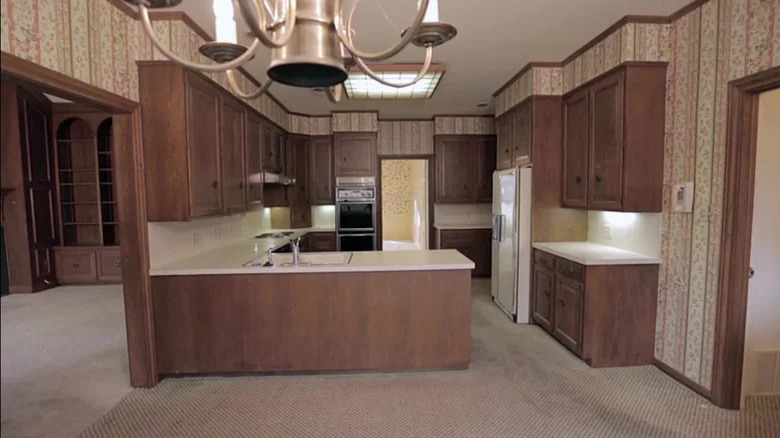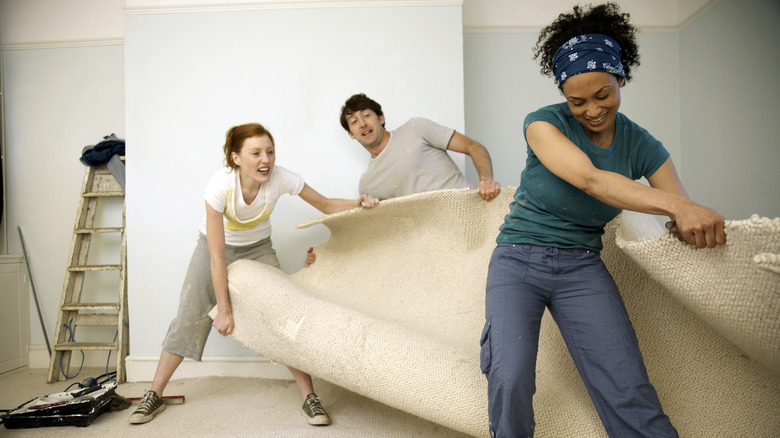The Home Design Choice Fixer Upper's Joanna Gaines Won't Tolerate In The Kitchen
Few interior designers can dream of the success and renown earned by Joanna Gaines. One-half of the spirited husband and wife duo behind HGTV's hit TV series "Fixer Upper," Joanna Gaines has received acclaim for her signature modern farmhouse style characterized by crisp whites, exposed natural wood, vintage touches, and shiplap... Lots of shiplap. Gaines' signature style has skyrocketed her from an HGTV TV host into a media and lifestyle mogul, best-selling author, and real estate empire owner. When it comes to home renovation, design, and furnishing — a more trustworthy name is difficult to find. With thousands of homes transformed from fixer-uppers to dream homes, it's clear that Joanna Gaines knows what works in a house and what doesn't.
When it comes to kitchens, you'll never find one thing in Gaines' renovations, and it's easy to understand why. In season 5, episode 11 of "Fixer Upper," Chip and Joanna renovated an outdated 80s-style farmhouse with a fully carpeted kitchen, proving that, indeed, the farmhouse look can go terribly wrong. The design duo brought the farmhouse kitchen into the 21st century with modern yet timeless upgrades. Understandably, the kitchen carpeting was the first thing to go, replaced by natural hardwood floors. A carpeted kitchen is a design and function faux pas for so many reasons, which we briefly discuss below. We also share Chip and Joanna's flooring preferences and tackle what to do if you purchase a home with a carpeted kitchen.
Why carpeted kitchens are a nightmare
Carpeted kitchens don't work for the same reasons carpeted bathrooms don't. Kitchens are high-traffic zones prone to spills, moisture, and messes. Falling food and liquids on the carpet create the perfect environment for mold, bacteria, and odor to thrive. Plus, carpeted kitchens are a hopelessly outdated design choice. In every room of the house, more people are getting rid of carpet flooring and replacing it with stylish, durable options. It's why you'll only see carpeted kitchens on the before footage of Joanna Gaines' renovations. On the other hand, hardwood flooring is a Chip and Joanna staple. It's prominent in their Texas farmhouse and is found in most of their projects. The pair also love antique or vintage tiles and restoring original hardwood floors.
But Gaines isn't opposed to adding a cozy carpet to a kitchen for warmth and character — she recommends it. Her blog notes that durability and the right color are key if a rug is desired in a kitchen or other high-traffic room. "You'll want to stick to a rug that has a pile height of one-quarter inch or shorter and has a pretty smooth surface that won't snag or pull," she says. "I'd also suggest avoiding rugs with primarily light colors in these high-traffic areas." A rug can add style, texture, and depth to a room, but for Gaines, it must fit the space's practical needs, and in busy areas, ease of cleaning is a must.
Removing carpeting in your kitchen
If you purchase a home with a carpeted kitchen and want your own "Fixer Upper" kitchen makeover, you'll first need to rip up the kitchen carpets like Chip and Joanna do. If you're lucky, you may find usable hardwood flooring underneath, which is a design dream come true. In this case, emulating Joanna Gaines and restoring these floors may be ideal. But you may also be left with an unsightly subfloor. Before you remove your carpet, it's useful to plan and budget for any subfloor repair that may need to be done and decide on the best kitchen flooring options for your space, taking into consideration design and cost.
Something important to look out for when removing carpet is the presence of asbestos, which may be present in the underlay if it was made during the 1960s or 1970s. Asbestos was also used in carpet adhesives until the 1980s. While ripping up carpet yourself is a fairly inexpensive task, if you're unsure when your carpeting was installed or what's underneath, it's best to get an asbestos analysis, as breathing in this substance can pose serious health risks. Another reason to hire a professional is the potential presence of mold in your subfloor, which will require specialized masks or respirators for removal and either treating or repairing and replacing the subfloor, depending on mold levels. While it's not the most fun renovation task, ripping up your kitchen carpets is a worthwhile hygiene, design, and functionality choice.


